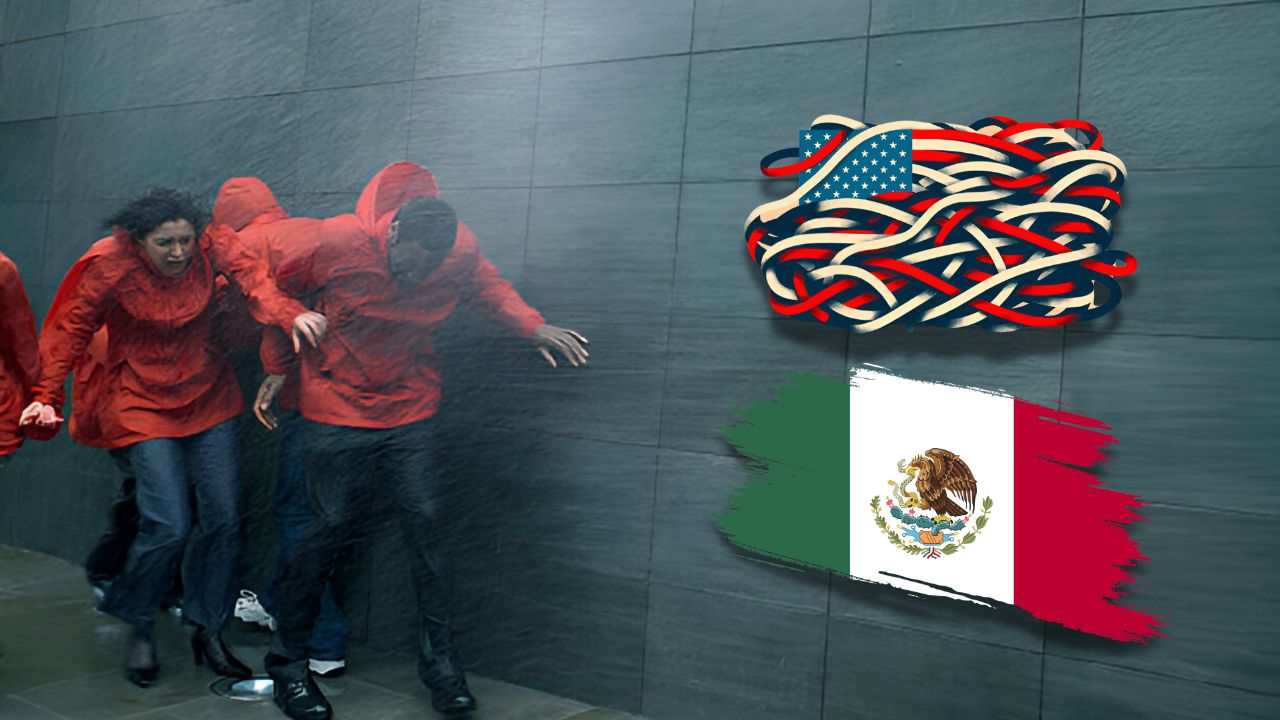On Friday, Mexican and US Customs and Border Protection officials met in Ciudad Juárez, Mexico, which is across the border from El Paso, Texas. They did this because of the recent rise in illegal crossings into the US, which caused an international bridge to be shut down and Mexico’s main freight train system to stop.
As part of the deal, Mexico decided to “depressurize” its northern towns, which neighbor El Paso, San Diego, and Eagle Pass, Texas, where the mayor has called a state of emergency. According to Mexico’s National Migration Institute, they will also take more than a dozen steps to stop migrants from putting their lives at risk by taking the train to the US-Mexico border.
How to Obtain a #REALID Before Your Next Flight.
— Action Games Now (AGN) (@ActionGameNow) January 2, 2025
The #NewYear2025 brings with it a number of significant new regulations for #visiting #visitors, including #updatedlaws for airline refunds, new #identificationhttps://t.co/ChZ8HmEmFk pic.twitter.com/TxexodUdoa
A Department of Homeland Security source says that more people are crossing the border between the US and Mexico. This week, more than 8,600 people crossed in one day. That’s up from about 3,500 border arrests per day before Title 42’s end in May, which made people who cross the border illegally face new penalties. On Monday, more than 8,000 people were caught.
Officials and non-profits in border towns on both sides of the US-Mexico line, from the Pacific Ocean to the Gulf of Mexico, say that the recent rise in movement could be caused by, among other things, false information and a rise in kidnappings in Mexico.
The official says that Del Rio, El Paso, the Lower Rio Grande Valley, and Tucson are the busiest areas. Each of these places has had more than 1,000 encounters in the last 24 hours. The Del Rio section includes Eagle Pass.
About 6,500 refugees are being held in El Paso, which “only has so many resources,” Mayor Oscar Leeser said at a news conference on Saturday.
“Right now, we’re at what we think of as a breaking point,” the mayor said.
Deputy City Manager Mario D’Agostino said at a news conference that an extra center in the northeast of the city planned to open its doors Saturday evening. This is because the number of migrants crossing the southern US border is at an all-time high, and the city is getting a lot of them.
The shelter, which will be run out of the Nations Tobin Recreation Center, has been set up over the “last couple weeks,” D’Agostino said. About 400 people can fit in the building.
D’Agostino said that El Paso is getting more than 2,000 new migrants every day, and that the city is getting ready for a “large influx” in the next few days.
The US Department of Defense has been moving more people and resources to the border. On Wednesday, the Department of Homeland Security said that at least 800 more active-duty soldiers would be joining the 2,500 National Guard members who were already there.
The top ambassador of Mexico said that her country has its own problems because of the recent rise: At a news meeting at the UN on Friday, Mexico’s Secretary of Foreign Affairs, Alicia Bárcena, said that the country gets about 6,000 refugees every day at its southern border, and about half of them are from Central American countries.
Bárcena said that about 11,000 migrants crossed the US-Mexico border on one day last week. He also said that Mexican President Andrés Manuel López Obrador wants to meet US President Joe Biden in Washington in November to talk about migration, as well as the trade of drugs and guns.
Mexico agrees to do fifteen things.
Acting Customs and Border Protection Commissioner Troy Miller, the head of Mexico’s National Migration Institute, the governor of the Mexican state of Chihuahua, members of Mexico’s national defense and national guard, and people from the Mexican railroad company Ferromex were all at the meeting on Friday, according to the institute.
As part of the deal, Mexican officials said they would do 15 things, some of which would involve working with Customs and Border Protection and Ferromex. For example, refugees would be sent back to their home countries by land and air.
The country said it will talk to the governments of Venezuela, Brazil, Nicaragua, Colombia, and Cuba to make sure that their people who were sent back from the US-Mexico border will be taken care of. It will also let US border patrol officers send people back through the international bridge in Ciudad Juárez that leads to El Paso.
US Customs and Border Protection said in a statement late Sunday that Miller “urged coordination of efforts to stop the rise of illegal migration and to keep legal trade and travel going.” He also stressed the need for coordinated engagement, such as mirrored patrols with local Mexican law enforcement agencies.
Miller said in a statement, “We are still working closely with our partners in Mexico to improve security and deal with illegal migration along our shared border.” “The United States and Mexico are still committed to stopping the flow of illegal migration caused by smugglers who don’t care about the people they hurt, while keeping legal pathways open.”
According to Mexico’s National Migration Institute, other parts of the agreement include giving Customs and Border Protection’s El Paso sector a daily report on the number of migrants on the train system, setting up checkpoints along the Ferromex rail route, and making interventions on railways and highways.
The center said that from January 1 to September, Mexico had sent more than 788,00 refugees back to their home countries.
The actions agreed upon by Mexican officials raise questions about whether the country is doing work that is usually done by the US from south of the border to deal with the influx of migrants in recent weeks, which CNN reported has put a strain on federal resources and filled up facilities that were already full.
People who want to find better, safer lives in the United States often have to travel long and risky distances to get there. Experts say that some people move to get away from crime, while others do it for work or to be with family. Worsening conditions in Latin America, which were made worse by the coronavirus outbreak, have also led to more people coming to the US.
Before the agreement with Mexico was made public, Ariel Ruiz Soto, a senior policy analyst at the nonpartisan Migration Policy Institute in Washington, told CNN last week that the number of border crossings was likely to rise “unless Mexico increases enforcement or something else happens in the region.”
But Ruiz said that one reason for the current rise in border crossings has nothing to do with the fact that more people are being deported from Mexico. Ruiz said that more people are leaving Mexico because crime is getting worse in some areas. He also said that the number of Mexican families coming to the border and likely asking for refuge has “increased significantly.”
US Customs and Border Protection says that 4,000 Mexican families will meet at the border in July 2022. A year later, the number had grown by more than four times, to nearly 22,000.
This is not the first time Mexico has decided to help the US with immigration regulation.
In 2019, experts said that the large number of Mexican National Guard troops had stopped many refugees from getting to the border.
Why is there such a big jump?
Sunday, the head of the Border Patrol said that traders are to blame for the new surge of migrants.
In a post on social media, US Border Patrol Chief Jason Owens said, “Smugglers are illegally crossing these large groups to make money and use them as a distraction to bring dangerous drugs and violent criminals into the U.S.”
Officials from the Department of Homeland Security who said last week that they were sending more help to the border didn’t say what could be causing the latest surge and said they were still looking into it.
Sister Norma Pimentel, the head of Catholic Charities of the Rio Grande Valley, says that last week, the Border Patrol released about 600 migrants per day to non-profit groups in McAllen, Texas. This is up from about 400 per day last month.
Pimentel said that an increase in kidnappings, threats, and bribes in the Mexican towns of Matamoros and Reynosa could be one reason for the quick rise in migrants moving between ports of entry.
“A lot of people are doing it,” Pimentel told CNN. “They don’t want to wait for their CBP One visit because they’re afraid for their lives.
Most of the people who come to the center are from Honduras, but Pimentel said there are also people from Ecuador, Colombia, Cuba, and Venezuela.
Glady Edith Caas, who runs the non-profit Ayudandoles a Triunfar, told CNN that about 4,500 migrants are waiting in shelters and camps in Matamoros, Mexico, which is close to Brownsville, Texas.
Caas says that some migrants are crossing between ports of entry because they heard false information that spread quickly among networks of migrants.
She said that people who cross the border, are processed by US border guards, and are then let into American cities send videos to people waiting in Mexico to tell them they’ve been “allowed” into the country.
“The migrants are filled with hope,” Caas said. “Word gets around so fast that they’ve been processed at the border with Matamoros, and then they cross the river, putting their lives at risk.”
About 5,500 migrants are waiting in shelters in Tijuana, Mexico, which is across the border from San Diego. The city’s head of migrant affairs, Enrique Lucero, says this.
Like Caas, Lucero says that migrant families who have been given release, a form of brief relief, by immigration officials spread false information that makes needy migrants cross the border illegally.
Eagle Pass, Texas, which has been the latest hot spot on the southern border, saw thousands of illegal immigrants cross the border in a single day last week.
Valeria Wheeler, who runs Mission Border Hope, a non-profit that helps migrants in the small town, says that this meant that the number of migrants dropped off by border patrol went from 300 per day to 500 or even 900 per day.









Comments are closed.